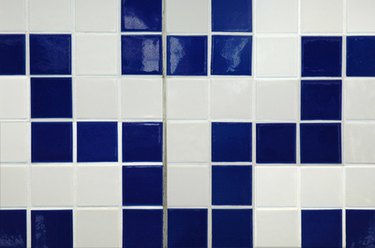
Ceramic tile has been a part of history for over 4,000 years. Components of ceramic tile are much the same as they were in ancient history, with its formula relying heavily on natural elements, primarily clay. By and large, ceramic tile is made of clay that has been baked at a high temperature in a kiln and then glazed in order to waterproof and beautify.
Clay
Video of the Day
Thick, malleable earth that can be formed to make building materials is known as clay. It is thick and difficult to dig through and has a gluelike quality. Clay is made of aluminum silicate. It has enough plasticity to be formed into flattened sheets that when baked at extremely high temperatures (in an oven called a kiln) it hardens and can be used in making roofing tile, decorative tile and bathroom tile that is waterproof once it is fired a second time with a silicate-based wet glaze that hardens into a glass coating that resists water and stains. Clay is common and can be excavated with much more ease than silica. Although there are many types of clay, Ball clay is used primarily for making ceramic tiles for use in housing and building materials.
Video of the Day
Additives
Ceramic tile does not simply consist of clay. Ball clay is processed with Cornish stone and flint to make a highly durable product. Cornish stone comes from Cornwall, England. Flint, a form of graphite that has been partially decomposed over thousands of years of exposure, comes from chalk beds and beaches. The flint is treated before it is added to the clay. It is broken down in a process that makes it easier to incorporate into the smooth clay for a product that is easy to work with.
Slip & Firing
Slip is the form that the clay takes before it is formed into tiles. Slip is the raw materials that have been blended and liquefied so that unwanted elements such as iron can be removed. Slip is moved quickly past an electromagnet to pull out the iron, which would make dark spots in the finished tile if allowed to stay in the mixture. The liquid is removed from the slip, and the resulting powder is formed with a bit of moisture into tiles and then fired in a kiln at 1,060 degrees. After cooling, the tiles are dipped in a glaze that will become its trademark shiny, and often colored, surface.
Glazes
Glaze is a silicon-based coating for tiles. Tiles are dipped in different glazes that have different chemicals added to produce different colors. Basically, glaze is a glass coating and requires high temperatures to change it from its liquid state to its smooth translucent finish. This requires a temperature of 750 degrees, as opposed to the much higher temperatures that are used to force the water from the clay. Once it has cooled, the tiles are packaged and shipped to different retailers for use in homes, offices, bathrooms and as roofing materials all around the world.